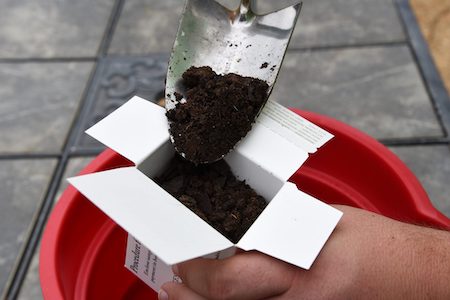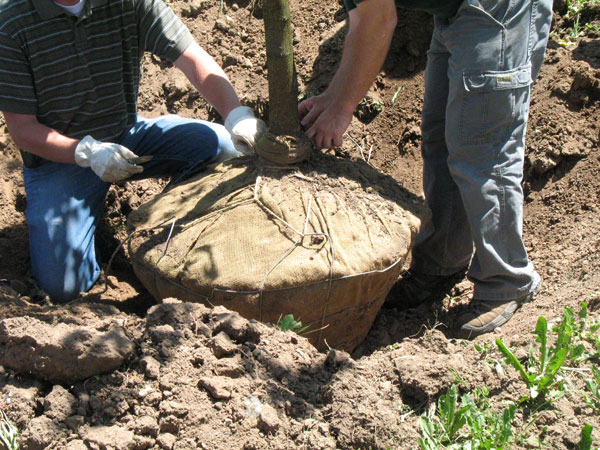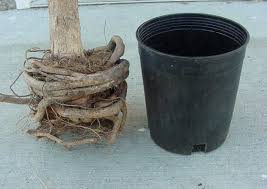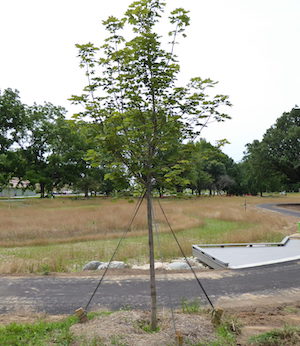Right Plant in the Right Place at the Right Time
by Carolyn R. Casey, Fairfax Master Gardener
Some of us have heard the term “right plant, right place.” Always keep this in mind when selecting trees and shrubs to add to your landscaping. Make sure that the plants that you select are healthy and will thrive in the conditions that you have in your yard and landscaping. Plants not suited to your landscaping are destined to fail from the beginning no matter how meticulously you plant them. Select disease and pest resistant trees and shrubs. Contact Miss Utility (dial 811) to have your underground utilities located and marked before you start digging.

Soil test box
A soil test done before your planting will determine the pH, nutrient levels and any added amendments needed for your soil. Test the soil for drainage and compaction before planting. For compacted soils, replace some of your soil with a suitable loam or add several inches of organic material like composted yard waste. Do not use sand in your garden since this will increase the compaction of your soil and decrease drainage.
It is important to make sure that you have the right amount of sun or shade for your trees and shrubs. Be sure to check the labels for information on your new plants. The place that you want to plant your tree or shrub needs to be large enough for its mature size.
Planting deciduous trees from September through November permits the roots to become established prior to the ground freezing and the coming of winter. Cool temperatures and warm soil in the fall, along with adequate moisture, will help trees become established. When the soil temperature stays above 40 degrees, the tree roots will continue to grow. Deciduous trees can be purchased bare-rooted for planting when they are dormant. Do not allow the roots to dry out; soak them in water before, during and after planting soon after purchase.
Evergreens should be planted in the late winter or early spring. Beware that evergreens hold onto their foliage during the winter. Because they keep their foliage they need to be kept watered in order to keep their foliage green. The intense sunlight and bitter winds during the winter may cause the needles to lose moisture, and the plant will not be able to take up enough water from the frozen ground. This may lead to the foliage becoming dry and with “winter burn.” Evergreens that have been recently planted have root systems that are too small for their canopies, making this worse.
Trees such as Dogwood (Cornus), Magnolia, Willow Oak (Quercus phellos), Tulip Poplar (Liliodendron tulipifera) and Yellowwood (Cladrastis kentukea) have fleshy roots and should be planted or transplanted in the spring. Shrubs including Mountain Laurel (Kalmia latifolia), Boxwood (Buxus) and Holly (Ilex) can be transplanted in the early fall. All of these will need to be mulched and watered deeply and regularly.
You will want to dig shallow planting holes that are two to three times as wide as the root ball. Digging wide and shallow holes will urge horizontal root growth. This is the kind of root growth that trees and shrubs naturally create.
When you have well-drained soil you will want to dig a hole for your plant as deep as the root ball. If you have poorly drained clay soil, you will want to dig the hole for your plant 1 to 2 inches shallower than the root ball and then cover the exposed root ball with mulch.
If you dig the hole deeper than the root ball or put loose soil beneath the roots, this will later cause compaction of the soil and lead to your plant being planted too deeply. You will want to expand the holes at the soil surface where most of the root growth occurs.

Planting ball and burlap tree
Look at the root ball of your plant to see how the roots are contained. B&B (balled and burlapped) is one way to contain the roots of plants. This way contains not only burlap but also synthetic materials that will not degrade. You will need to remove any pins, nails or rope. Then cut away or drop the wrapping material into the hole and then backfill the hole.
Balled and burlapped as well as container plants can be planted whenever the soil is not frozen. Lift plants by the container or root ball and not by the stems or trunk. Wet soil may reduce growth and survival, so you should plant in well-drained soil.
Another way that is used to contain plant roots is wire baskets. The wire baskets will degrade over time after being put in the ground. You need to remove the top 8 to 12 inches of the wire to keep equipment from becoming caught in the wire loops and to keep the roots from girdling.
Plant roots are also contained in plastic pots. You must remove plants from these containers. Some plants are also grown in fiber pots made of wood, coir or peat. With fiber pots, you will need to break away the top or remove the plant from the pot. Fiber pots may be coated with a product that extends their shelf life. This causes the pots to slowly break down when planted under the ground and retards the plants’ root extension.

Girdling roots from growing in container
Sometimes when plastic or fiber pots are used to contain the roots of the plant the roots are found to be circling around the root ball. When you find the roots like this you need to make a few vertical cuts around the root ball. Then gently splay the roots away from the center. A knife can be used to cut through larger roots. This keeps the roots from later girdling the trunk. You will want to choose plants grown in containers that have vertical ribs or have a copper treatment on the interior walls of these containers. These containers sometimes prevent circling root formation.
When you backfill the hole do not add any organic matter. This will slow the establishment of the plant and may kill young plants. But you will want to add slow-release granular fertilizers to the backfill. This will add nitrogen and any needed elements that your soil test suggested that you add. Do not use more than 1 pound of actual nitrogen per 1,000 feet of planting hole surface. Do not use fast release agronomic fertilizers, as this may cause the roots of your plant to become dehydrated. Use the unamended soil that you had left over to fill the hole. As you backfill the hole put half of the soil in and then water to help the soil settle and to prevent air pockets. Once you have finished backfilling the hole, you want to water it again and cover the exposed root ball with mulch.
After you have planted your trees and shrubs, you will want to remove all tags and labels to avoid girdling branches and trunks.
You can promote the root growth of your plant by providing effective supplemental watering. This is necessary for the plant to become established. Before watering you want to check the soil several inches below the mulch and root ball to feel if it is dry. Overwatering may deprive the roots of vital oxygen. There are drip irrigation systems and rain barrels that can help with watering.
It is a good idea to mulch your plant with 2 to 3 inches of mulch out to the farthest branches, also known as the dripline. This decreases the struggle for nutrients and moisture and protects the trunk from damage. It is good to use organic mulches like shredded or chunk pine bark, pine straw and composts. You can also use inorganic mulches like volcanic and river rock. You do not want the mulch to touch the trunk or stems of your plant. This helps to prevent disease and rodent problems when using organic mulches. It also prevents bark abrasions from occurring to your plant when you use inorganic mulches.
Do not put black plastic around your plant since it prevents air and water exchange. If you are trying to control weeds you can use a landscape fabric that resists weed root penetration and then apply 1 to 2 inches of mulch to help prevent weeds.

Tree guy wires and stakes
Stake only trees that have large crowns or are planted in a windy area or an area that can be pushed over by a person. Do not stake a tree for any longer than a year or tree girdling may occur. Use 5- to 6-foot-tall wooden stakes driven into the ground near the base of the plant but not into the root ball. Secure the tree to the stakes with padded wire or plastic tree ties. Make sure that the tree can sway slightly in every direction. When staking plants, you can protect the bark by covering the wire with short pieces of hose or flexible tubing. Guying uses 3 equally spaced wires anchored to the ground and provides the best support for large trees. It is designed to be temporary and is typically used on larger trees that are transplanted balled-and-burlapped. The wires are loosely looped around the tree trunk right above the lowest branches. Allow enough slack in the wires for some trunk movement.
Newly planted plants do not need to be pruned except to remove broken, damaged branches or to correct branch structure. The leaves are needed to produce photosynthesis to create energy for root growth and growth hormones to speed root establishment.
The wrapping of tree trunks increases insects, disease and water damage to trunks. The use of white wrapping may benefit trees that have thin bark that are planted in the spring or summer especially in areas that are hot or paved areas. Do not attach the wrap with wire, nylon, plastic ties or electrical tape; the use of these items may cause trunk girdling. Wraps need to be removed after one year.
You may need to protect your new plant from animal damage. Install guards to protect the trunk or stems of your plant. The guards need to fit loosely and allow for air circulation.
If you follow these guidelines, you can achieve successful planting of trees and shrubs in your landscape design, thus achieving happy gardening.
Resources
• Planting a Tree or Shrub, University of Maryland Extension
• Tree and Shrub Planting Guidelines, Bonnie Lee Appleton, Susan French, David Close, Virginia
Cooperative Extension
• Shrubs: Functions, Planting, and Maintenance, Alex X. Niemiera, Virginia Cooperative Extension
• Planting Trees, Diane Relf, Virginia Cooperative Extension
• Planting Trees, Virginia Department of Forestry
• The Ornamental Garden in November, Susan Martin, Piedmont Master Gardeners, Virginia
Cooperative Extension
• Tree Staking, Purdue University Extension — Forestry and Natural Resources